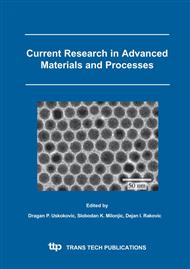p.1
p.7
p.13
p.19
p.25
p.31
p.37
p.43
p.49
GaAs/AlGaAs Quantum Cascade Lasers Based on Double Resonant Electron – LO Phonon Transitions
Abstract:
In this paper a procedure for the global optimization of mid-infrared GaAs/AlGaAs quantum cascade lasers that relies on the method of simulated annealing is presented. We propose a double longitudinal optical phonon resonance design obtained via a ladder of three states, with subsequent pairs separated by optical phonon energy. Addition of an extra level decreases the lower laser level population by enabling an efficient extraction into the injector region. The output characteristics of the optimized structures are calculated using the full self–consistent rate equation model, which includes all of the relevant scattering mechanisms. We also presented the experimentally measured output characteristics of an initial device, which are in agreement with the numerically calculated values, confirming the good design capabilities of the applied procedure.
Info:
Periodical:
Pages:
25-30
Citation:
Online since:
September 2005
Authors:
Price:
Сopyright:
© 2005 Trans Tech Publications Ltd. All Rights Reserved
Share:
Citation:


